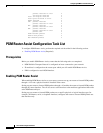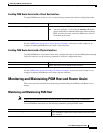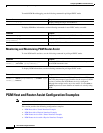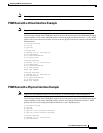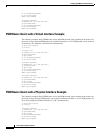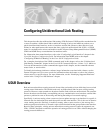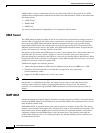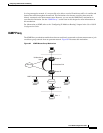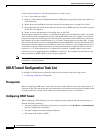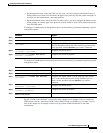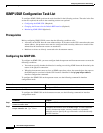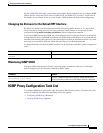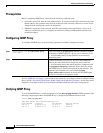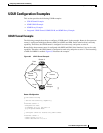
Configuring Unidirectional Link Routing
UDLR Overview
IPC-506
Cisco IOS IP Configuration Guide
UDLR enables a router to emulate the behavior of a bidirectional link for IP operations over UDLs.
UDLR has three complementary mechanisms for bidirectional link emulation, which are described in the
following sections:
• UDLR Tunnel
• IGMP UDLR
• IGMP Proxy
You can use each mechanism independently or in conjunction with the others.
UDLR Tunnel
The UDLR tunnel mechanism enables IP and its associated unicast and multicast routing protocols to
treat the UDL as being logically bidirectional. A packet that is destined on a receive-only interface is
picked up by the UDLR tunnel mechanism and sent to an upstream router using a generic routing
encapsulation (GRE) tunnel. The control traffic flows in the opposite direction as the user data flow.
When the upstream router receives this packet, the UDLR tunnel mechanism makes it appear that the
packet was received on a send-only interface on the UDL.
The purpose of the unidirectional GRE tunnel is to move control packets from a downstream node to an
upstream node. The one-way tunnel is mapped to a one-way interface (that goes in the opposite
direction). Mapping is performed at the link layer, so the one-way interface appears bidirectional. When
the upstream node receives packets over the tunnel, it must make the upper-layer protocols act as if the
packets were received on the send-capable UDL.
UDLR tunnel supports the following features:
• Address Resolution Protocol (ARP) and Next Hop Resolution Protocol (NHRP) over a UDL
• Emulation of bidirectional links for all IP traffic (as opposed to only control-only
broadcast/multicast traffic)
• Support for IP GRE multipoint at a receive-only tunnel
Note A UDL router can have many routing peers, for example, routers interconnected via a broadcast
satellite link. As with bidirectional links, the number of peer routers a router has must be kept
relatively small to limit the volume of routing updates that must be processed. For multicast
operation, we recommend using the IGMP UDLR mechanism when interconnecting more than 20
routers.
IGMP UDLR
Another mechanism that enables support of multicast routing protocols over UDLs is using IP multicast
routing with IGMP, which has been enhanced to accommodate UDLR. This mechanism scales well for
many broadcast satellite links.
With IGMP UDLR, an upstream router sends periodic queries for members on the UDL. The queries
include a unicast address of the router that is not the unicast address of the unidirectional interface. The
downstream routers forward IGMP reports received from directly connected members (on interfaces
configured to helper forward IGMP reports) to the upstream router. The upstream router adds the
unidirectional interface to the (*, G) outgoing interface list, thereby enabling multicast packets to be
forwarded down the UDL.



